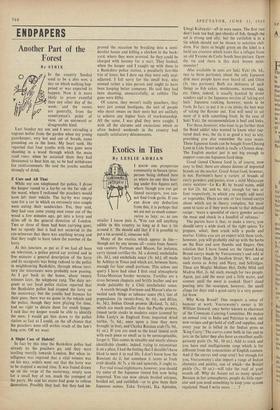Exotics in Tins
By LESLIE ADRIAN Many of the exotics which appear in tins— though not by any means all—come from Ameri- can canners. Fortnum and Mason, for instance, carry tinned tortillas (6s. 3d. a dozen), encheladas (4s. 3d.), and enchelada sauce (3s. 6d.), all made by Ashleys in Texas and which are, between them, enough for four small portions. This solves one query I have had since I first read atmospheric Texas-Mexican border westerns. Tortillas are a cross between chupatis and brittle leather and are made palatable by a Chili (enchelada) sauce.
A search through Fortnum and Mason's also re- vealed such things as tabasco sauce (4s.), tins of poppadums (in twenty-fives, 4s. 6d., and fifties, 6s. 3d.), Indian Ocean prawns (Roland, 7s. 6d.), which are much smaller than the Pacific prawns, tinned turtle steaks in madeira sauce (canned by John Lusty's in England from imported dried turtles, 7s. 6d.; once upon a time they were brought in live), and Chatka Russian crab (7s. 9d., 6f oz.). If you are used to the local tinned crab with each piece so small as to be unrecognisable, forget it. This comes in sizeable and nearly always identifiable chunks; indeed, trying to reconstruct it on a plate, I had the feeling that I shouldn't have liked to meet it in real life. I don't know how the Russians do it, but somehow it tastes as fresh crab should. At 7s. a tin and upwards, it ought to.
For real visual nightmares, however, you should try some of the Japanese tinned fish now being imported. You can now obtain broiled octopus, broiled eel, and cuttlefish—or to give them their Japanese names, Tako Teriyaki, Ika Ajatsuke, Unagi Kabayaki—all in soya sauce. The first two don't look too bad, just chunks of fish, though the eel is strong and oily; but the cuttlefish is in a tin which should not be shown to sensitive chil- dren. For there in bright green on the label is a lurid sea creature which looks like a refugee from an old Yvonne de Carlo South Seas picture. Open the tin and there is this dark brown mini- monster!
Also available in cans are Suki Yaki (4s. 6d., two to three portions), about the only Japanese dish most people have ever heard of, and Oden (3s. two portions). Both are mixtures of such
things as fish cakes, mushrooms, seaweed, egg, etc. Oden, indeed, is usually hawked by street vendors and is the Japanese version of `taking pot luck.' Japanese cooking. however, needs to be fresh. In fact, to put it in a tin seems the best way of taking the flavour out. You will need to eat most of it with something fresh. In the case of Suki Yaki, the recommendation is beef and leeks.
For those, however, who want to go further than the Bond addict who wanted to know what rup- tured duck was, the tin is as good a way as any, providing you also remember the soya sauce. These Japanese foods can be bought from Cheong Leen in Lisle Street which is really a Chinese shop. The English market just is not big enough to support even one Japanese food shop.
Good tinned Chinese food is, of course, now easy to find; there are almost dozens of imported brands on the market. Good Asian food, however,
is not. Fortnum's have a variety of brands of curry powders and pastes, even a mild Malaysian
curry mixture—Le Ka Ri by brand name, mild or hot (2s. 6d. and 6s. 6d.), enough for two or four respectively, to which you simply add meat or vegetables. There are one or two tinned currys about which are in theory complete, but most seem to taste as if they were made to that debased recipe: `wave a spoonful of curry powder across the meat and chuck in a handful of sultanas.'
The purists have it that, to make a curry, you should carry a wide stock of the right spices. To prepare, select, then crush with a pestle and mortar. Unless you are an expert with these tools, however, you will probably end up with the herbs on the floor and sore thumbs and fingers. One solution that I have found are the tinned King Brand currys made by Veeraswamy's and sold at their Curry Shop, 20 Swallow Street, WI, and at such stores as Army and Navy, and Selfridges. These are Moglai Medium Hot, Delhi Mild and Madras Hot, 2s. 6d. each, enough for two people.
Again, just add the meat and a little water, and simmer until the meat is cooked. Don't stand peering into the saucepan, however, the smell clings for days and a good curry is a very power- ful brew.
Why King Brand? One suspects a sense of humour at work. Veeraswamy's owner is Sir William Steward, once better known as chairman of the Commons Catering Committee. He makes an annual visit to India and Pakistan to seek out new recipes and get hold of staff and supplies; and every year he is billed in the Indian press as `King Curry.' The currys come both in tins and in jars; in the latter they also have an excellent mulli- gatawny paste (3s. 9d., 10 oz.). Add to stock and you have real mulligatawny soup which is far different from the concoctions of English canners.
And if the currys and soup aren't hot enough for you, Veeraswamy's also import a range of Indian chutneys and pickles, one of which—the Brinjal pickle (Ss., 10 oz.)—will take the roof of your mouth off. Why do Asians eat so many spices?
Because in hot atmospheres, people do little exer- cise and you need something to keep your system regulated. Need I write more . . .?


































 Previous page
Previous page